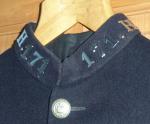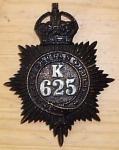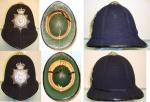
ayedeeyew
Active Contributor-
Posts
103 -
Joined
-
Last visited
Content Type
Profiles
Forums
Blogs
Gallery
Events
Store
Everything posted by ayedeeyew
-
As an update, I finally got the 1888 kit together to a standard I was happy with in time for some volunteer work at CHSW with the local Victorian Evening last Friday. The real Police were sufficiently interested as to my getting a mention on Twitter: https://twitter.com/ASPNSomerset/status/411581015963205632/photo/1
-
Sorry Meryyn, but I'm going to have to stick to my guns here - it is inconceivable to my mind that any form of marking to a specific dockyard would be allowed that EXACTLY mimicked an already well known and well established military marking. It would defeat the original point of creating a mark that clearly denoted that an item was military/Government property. I can offer further evidence in that I myself own a very similar truncheon. 17 inches, marked Field on the end, with the 59 Lemans Street address that dates it to 1877 or very soon after. It is unpainted now, but there is evidence to suggest this may have been stripped off at a later date. Just above the grip it has been stamped K over 552, which would mean it was originally for Stepney if it is a Metropolitan Police truncheon. Like the original posters truncheon, the address has been heavily over-stamped with the W/iD at some point, and also has had the WD surmounted by the /i (the two standard military forms of this marking that are usually encountered) stamped near the top. Given that the Metropolitan Police made carrying the shorter 15 inch truncheons in a long trouser pocket the norm in 1887 (as part of the change-over from carrying it in a truncheon case on the belt), it is my conjecture that some use was found for the now obsolete longer pattern. Giving them to the military (who, as you point out, rarely used them) would thus make logical sense. This particular truncheon is a favourite of mine, not least it was the first I acquired, being very cheaply priced, became a Christmas present, and appealed to both my newly developing Police interest and my long established military collection: http://postimg.org/image/pae0xn7fj/ http://postimg.org/image/y6cla8bjf/ http://postimg.org/image/gznj6u6z1/ http://postimg.org/image/wr8623zip/
-
Thanks for the information Monty. Mine came from Neil Storey, and given the number is solid cast as part of it I did wonder if I could expect to see another H171 in future. If you need any collar H's I eventually found a supplier who had multiple originals I can highly recommend... I must get on and put some updated photos up, the tunic looks great with the correct collar insignia all in place.
-
I recently purchased on Ebay a 1927 copy of the "Official Handbook" of the Metropolitan Special Constabulary Reserve and a blank notebook, both named to "Sergeant J.H.Gough, Metropolitan Police Reserves, N. Division,Tottenham", with the additional address "71 Lansdowne Road, Tottenham, N17." I wondered if anyone might be able to help me find if there is any further information on his career, etc, available?
-
There's a TV series in the UK just started called "Ripper Street", set in Whitechapel in 1889. Main character had an oil lamp which he used several times, but the light coming out of it was very steady, white and bright - almost like there was a bulb and battery in it rather than oil or candle (which gives off a much less stable and yellowish light)...
-
I did wonder how far cost might have come into the design, one force being happy to spend more and get the best available, another going for the cheap'n'cheerful approach. I am generally of the buy once, buy best approach, tends to work out cheaper in the long run... I forgot to say mine also has very minimal ventilation to the main body, only 8 holes punched by the clip, and the same to the inner part (of which two have been covered during manufacture by the silvered reflector being soldered over them), and even in use these rarely line up perfectly. Heat rising would naturally result in fresh air being drawn in through even such minimal gaps. I am actually quite happy with it's repaint job, as I probably would have had to do it anyway to spruce up the exterior. I have actually been looking into the leather guards recently as part of the kit I still need to replicate, as originals are somewhat scarce and I wouldn't want to risk damaging a survivor further with a hot lamp today. They were seperate to the belt, and only added when needed. From an example pictured on the web, in a book, and in two museums there is a suprising amount of variation in shape and construction, from a simple sheet with two slits to elaborate versions with multiple straps added to the backing. Examples below: http://postimage.org/image/6gubxf3kr/full/ http://postimage.org/image/5orapkcip/ This one is somewhat tweaked by myself, but based on a museum original: http://postimage.org/image/7t1bsns5t/ Also: http://postimage.org/image/5scr0buwl/ And a photo-based period illustration of lamp and guard in use: http://postimage.org/image/lk6rlkjx9/
-
I thought I might add something to this thread, based on the use of my own Police lamp I originally posted pictures of in the thread I started on Met Police kit: http://postimage.org/image/7iffa9ngn/ http://postimage.org/image/wp30t7cun/ I believe this to be quite an early example of it's type, and (less a relatively modern repaint in black at some point) it is still complete and in working order. Even if it has been running for some time, holding it by the body is no problem. I believe the handle are there simply to ensure certainty of grip when in use, as the body doesn't get anywhere near hot enough to prevent a bare hand from touching it with any risk of burning. The cone on the top is another matter. My example only has one cone, and after even a short period of use that gets hot enough to burn yourself if you are not careful. I believe this is more the reason subsequent cones were added on top, as ventilation with one cone works perfectly well, but other cones would cover the one taking most of the heat, and help reduce the risk of burnt fingers. My example also lacks a protecting rim for the lens, an adjustor for the wick (it must be pulled up by hand, or the top unscrewed and pulled back in by hand again to adjust the height - result = parrafin/soot covered fingers!), or an external switch to "black out" the flame (again it must be manually turned by hand - no mean feat given the easiest way is by the cone which is inevitably very hot!). I think early examples like this showed up such deficiencies in use, and that later examples can be noted as such from the gradual adoption of features that overcame them.
-
Thanks for those Mervyn, the shot in greatcoat is of particular interest to me as it is another item of kit I am after. I know what they look like from the front, but have yet to find a good shot (or an original) which I can get the details for the reverse off... When I started the other thread, you mentioned you might be able to help with a "King's Crown numbered plate and possibly a belt (also, a wool cape)" - any update with this?
-
Giving this one a bump, with some updates. Trying to get my kit sorted out for a possible event at the start of December. I've sorted myself out for a helmet/plate now, so working towards collar number H. 171 to match: http://postimage.org/image/kuy2xf72n/ I have a pair of 171's, but have been struggling to find any H's of the right size: http://postimage.org/image/a4w885qw1/ If anyone knows of any dealers, etc, that might have a pair or preferably several pair of chrome/white metal H's, preferably about 2cm tall with thread fittings (or slightly taller/shorter at a pinch, with loops or prongs) they are all I need to finish off my jacket now. I am also getting close to having some leatherwork copied - does anyone here have access to one of these leather guards for use with the oil lamp? I want to get a copy made up to use with my lamp, but from the few pictures I've been able to find I'm struggling on the detail: http://postimage.org/image/6gubxf3kr/full/ http://postimage.org/image/5orapkcip/
-
Indeed, my original has to be folded very carefully to minimise the waterproof coating in contact with the same, otherwise it tends to stick to itself! This week I received the last QVC Metropolitan Police button in the post, giving me: http://postimage.org/image/v8c7l0hpz/ I took the 10 most closely matched/best condition buttons, and five hours of sewing them on (and moving the duty-band loops down a little) left me with: http://postimage.org/image/dm4zlvuaz/ And the reverse: http://postimage.org/image/db6btp0pv/ The cuff band is a modern repro which I have added a buckle to. The numbers are just a matched set I put on to fill the gap until I get an appropriate helmet plate to match to. If anyone has a matched pair of the approximately 3/4 inch white metal/chromed "H"s for Whitechapel or a pair of "full-stops" that go between them and the numbers (at Angels we used cut-down split pins painted silver for the purpose) then I am after these at present. Incidentally, after I sewed the buttons on I saw the following postcard on Ebay: http://postimage.org/image/joh7q484r/ Whilst an artists picture is not always a reliable indicator of fact, in this case it does quite nicely show off only two buttons being worn at the waist on the back of the jacket.
-
Linking back to the capes again - an original unissued 1960's cape holder I bought on Ebay. I believe these to be of a pattern as used during the 19th century, but again would appreciate any further information as to their date span and use (eg where these for both the wool and oilskin capes, and how would a cape be folded for carriage in such a holder). As this is completely mint if anyone has a used example they want to part with I would also be interested: http://postimage.org/image/lh1k90w2j/full/
-
Back to belt kit - bulls-eye lantern I own, Met used oil lanterns of this style between 1840 and 1920 (when they moved to electrical torches). This particular example is very basic in construction but in full working order (I lit it up tonight to take the pictures outside, it has a delightful life to the light it gives that electricity cannot compare to): http://postimage.org/image/7iffa9ngn/ http://postimage.org/image/wp30t7cun/
-
And my other cape - this was one of many that came to Oxfam with the ex-Angels kit, and I believe it to be an older reproduction as the only marking is a sewn in card tag for 5 capes. If it is a copy it is very well done, the only slight curiousity being they fasten at the collar in the opposite fashion to my known original: http://postimage.org/image/nlfhqx29p/full/ http://postimage.org/image/4v73vrnm3/ http://postimage.org/image/7sbgda5jr/full/
-
Capes - oilskin raincapes in this case. I own two, the first is an original Met issue one, and further information as to the date span of issue for these would be appreciated: The cape in general http://postimage.org/image/r75trns9b/full/ [/url] Met mark http://postimage.org/image/61ibhhj25/ [/url] Makers mark - unfortunately double stamped originally, and very difficult to read as a result, any one who can fill in the gaps? http://postimage.org/image/g64knwuap/ [/url]
-
Thanks for the reply Mervyn, glad to see I'm not talking to myself . The additional information on the jacket buttons is good. As a result of me cataloging the 579 boxes of ex-Angels kit our Oxfam alone received I ended up getting an internship with Angels uniform department in Hendon for 2 months back in the summer of 2010, so got to see a lot of what goes on behind the scenes (anyone who saw the two Policeman in the TV version of "The Crimson Petal and the White" will have seen a lot of my handiwork!). The vast majority of the jackets Angels used were like mine, ex-Police original dress versions, often rebadged and renumbered many times (hence the collar on mine has been replaced at some point due to the original having been destroyed). As buttons come and go with alarming frequency I wanted to be sure that the four hole piercing wasn't a modification done to represent another force or period at some point in Angels use of it. I have not seen a copy of your book, so another good thing to add to the list to look for. Most books I have seen searching on Ebay tend to focus either on the force history, or just the buttons/badges aspect, and not the whole package in any detail. The sound of a possible belt, plate and cape also sound excellent, I have been busy with the camera tonight for another spate of posts and questions which link in particularly with the latter.
-
Belt - the 2 1/2 inch wide snake-clasp black leather version, introduced to all ranks in 1862. Pictures of the example below posted by a previous poster. I am looking to obtain one like this: http://postimage.org/image/wq6atj31z/ http://postimage.org/image/ephzl9rip/ http://postimage.org/image/mz8z3k4l3/ http://postimage.org/image/9uw3sd8l7/
-
To a jacket - I volunteer for the local Oxfam "Hub", and back in 2010 we were one of a number of Hubs that received a large donation of items from Angels the Costumiers in London. I obtained a number of items for my use and collection from this (including an original 1918 dated jacket I believe is for dress purposes, which sparked the Police kit interest), and the following 8-button tunic (made in 1956) thats fits me, of the style introduced in 1864. I aim to replace the missing buttons with original QVC London Metropolitan Police buttons, of which I already have sufficient numbers to do the job. However, I have seen somewhat contradictory information as to how many buttons it should have. I know it should have 8 down the front, but I have seen information that says only two should be worn on the back (at the waist), yet I have seen various pictures from the period that would seem to suggest another two were worn lower down on the panels (and indeed the jacket is pierced for four buttons). Is four buttons on the rear a later change, and if so when was it introduced? http://postimage.org/image/czn9f3anv/ http://postimage.org/image/ggcgfoix1/full/ http://postimage.org/image/xpf58yhe5/
-
Hello, this a first posting by myself, although I have been lurking for quite a while now. My name is Andrew Upton, a long standing WW1 reenactor, but last year as a result of some good fortune I decided to branch out into another area that has interested me for some time, namely Police kit of the late 19th/early 20th century. Having looked extensively through this section of the forum last night I am now certain some of my questions I am struggling to answer at the moment might be found here. I have decided to concentrate on the Metropolitan Police, given its long-standing history and large size, and focus on two main dates. The second covers the Great War, and I am looking to expand into this when the first is up and running. This is the period 1880-90, more specifically c.1888, Whitechapel… To break things up, I will start at the top and work down! One item I am currently trying to locate is a replica London Metropolitan Police helmet plate of the pattern used at the end of the 19th century (the style illustrated below, with the Guelphic Crown). Given I am aiming for Whitechapel, one with an H prefix would be preferable, however if it was a good copy with removable numbers like the originals then this is unimportant as I can change it. This is holding me back on the tunic front at the moment, since whatever number is on the plate will ultimately have to go on the collar as well, so I cannot finish the tunic until I have located one. As I understand it, copies of this were quite abundant about 5-10 years ago, yet seem to be rarely seen today (and often seem to go for a tidy bundle on Ebay when they do appear!): I am also looking for one of the later Kings Crown version, either original or reproduction (as seen below): To end this first post, I am also looking for a suitable cork helmet for the late 19th century. As I understand it, for the Met this should be cork, 6-panelled, rose-topped, with a single vent either side, a metal band around the body (metal fittings being blackened). I have seen the following two helmets for sale on a dealers site. Both are my size (7 1/8). To my eye the top helmet seems to generally fit the pattern, with the exception of the cloth band as opposed to metal (which I believe would be easily swapped over). The lower seems to have the right sort of fittings, but the style seems somewhat off to my eye. Any comments or suggestions would be appreciated: More to come later!





